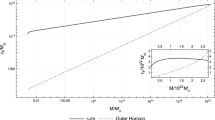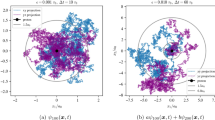Appendix
The total Hamiltonian of the scalar QFT is \({ \hat {H}}(t)={\ {\int \limits } d^{N}x{\hat {{\mathcal{H}}}}(x)}\), where the Hamiltonian density, \({{\hat {{\mathcal{H}}}}}\), has been given in (2.1) – (2.5). For the three-body system, the matrix element for the rest-plus-kinetic energy is as the following:
$$ \langle \psi_{3}|:{\hat{H}}_{\phi }-E:|\psi_{3}\rangle =\int d^{N}p_{1}d^{N}p_{2}d^{N}p_{3}F^{\ast }(\mathbf{p}_{1},\mathbf{p}_{2}, \mathbf{p}_{3})F(\mathbf{p}_{1},\mathbf{p}_{2},\mathbf{p}_{3})\left[\omega_{p_{1}}+\omega_{p_{2}}+\omega_{p_{3}}-E\right]. $$
(4.1)
The matrix element for the interactions is \(\langle \psi _{3}|:{\hat {H}} _{I}:|\psi _{3}\rangle =[G1]+[G2]+[G3]+[A1]+[A2]\), where we have:
$$ \begin{array}{@{}rcl@{}} \langle \psi_{3}| &:&{\hat{H}}_{I_{2}}{ }:{ \ }|\psi_{3}\rangle = \\ &&\int d^{N}p_{1}d^{N}p_{2}d^{N}p_{3}d^{N}p_{1}^{\prime }d^{N}p_{2}^{\prime }d^{N}p_{3}^{\prime }F^{\ast }(\mathbf{p}_{1},\mathbf{p}_{2},\mathbf{p} _{3})F(\mathbf{p}_{1}^{\prime },\mathbf{p}_{2}^{\prime },\mathbf{p} _{3}^{\prime }) \\ &&\times \left\{\left[ -\frac{g^{2}}{4(2\pi )^{N}}\delta^{N}(\mathbf{p} _{1}^{\prime }+\mathbf{p}_{3}^{\prime }-\mathbf{p}_{1}-\mathbf{p}_{3})\delta^{N}(\mathbf{p}_{2}^{\prime }-\mathbf{p}_{2})\frac{1}{\sqrt{\omega_{p_{1}^{\prime }}\omega_{p_{3}^{\prime }}\omega_{p_{1}}\omega_{p_{3}}}} \frac{1}{\mu^{2}-(p_{3}-p_{3}^{\prime })^{2}}\right]_{G1} \right. \\ &&+\left[ -\frac{g^{2}}{4(2\pi )^{N}}\delta^{N}(\mathbf{p}_{1}^{\prime }+ \mathbf{p}_{2}^{\prime }-\mathbf{p}_{1}-\mathbf{p}_{2})\delta^{N}(\mathbf{p} _{3}^{\prime }-\mathbf{p}_{3})\frac{1}{\sqrt{\omega_{p_{1}^{\prime }}\omega_{p_{2}^{\prime }}\omega_{p_{1}}\omega_{p_{2}}}}\frac{1}{\mu^{2}-(p_{1}-p_{1}^{\prime })^{2}}\right]_{G2} \\ &&+\left[ -\frac{g^{2}}{4(2\pi )^{N}}\delta^{N}(\mathbf{p}_{2}^{\prime }+ \mathbf{p}_{3}^{\prime }-\mathbf{p}_{2}-\mathbf{p}_{3})\delta^{N}(\mathbf{p} _{1}^{\prime }-\mathbf{p}_{1})\frac{1}{\sqrt{\omega_{p_{2}^{\prime }}\omega_{p_{3}^{\prime }}\omega_{p_{2}}\omega_{p_{3}}}}\frac{1}{\mu^{2}-(p_{2}-p_{2}^{\prime })^{2}}\right]_{G3} \\ &&+\left[ -\frac{g^{2}}{4(2\pi )^{N}}\delta^{N}(\mathbf{p}_{1}^{\prime }+ \mathbf{p}_{2}^{\prime }-\mathbf{p}_{1}-\mathbf{p}_{2})\delta^{N}(\mathbf{p} _{3}^{\prime }-\mathbf{p}_{3})\frac{1}{\sqrt{\omega_{p_{1}^{\prime }}\omega_{p_{2}^{\prime }}\omega_{p_{1}}\omega_{p_{2}}}}\frac{1}{\mu^{2}-(p_{2}+p_{1})^{2}}\right]_{A_{1}} \\ &&+\left.\left[ -\frac{g^{2}}{4(2\pi )^{N}}\delta^{N}(\mathbf{p}_{1}^{\prime }+ \mathbf{p}_{3}^{\prime }-\mathbf{p}_{1}-\mathbf{p}_{3})\delta^{N}(\mathbf{p} _{2}^{\prime }-\mathbf{p}_{2})\frac{1}{\sqrt{\omega_{p_{1}^{\prime }}\omega_{p_{3}^{\prime }}\omega_{p_{1}}\omega_{p_{3}}}}\frac{1}{\mu^{2}-(p_{1}^{\prime }+p_{3}^{\prime })^{2}}\right]_{A_{2}}\vphantom{\left\{\left[ -\frac{g^{2}}{4(2\pi )^{N}}\delta^{N}(\mathbf{p} _{1}^{\prime }+\mathbf{p}_{3}^{\prime }-\mathbf{p}_{1}-\mathbf{p}_{3})\delta^{N}(\mathbf{p}_{2}^{\prime }-\mathbf{p}_{2})\frac{1}{\sqrt{\omega_{p_{1}^{\prime }}\omega_{p_{3}^{\prime }}\omega_{p_{1}}\omega_{p_{3}}}} \frac{1}{\mu^{2}-(p_{3}-p_{3}^{\prime })^{2}}\right]_{G1} \right.}\right\} \\ && \end{array} $$
(4.2)
One should note that the total Hamiltonian is \({\hat {H}}={\hat {H}}_{\phi }+{\hat {H}}_{I}\) where \({\hat {H}}_{I}\) is the total interaction and as mentioned in the manuscript the interaction terms consist of two parts (\({\hat {H}}_{I_{1}}\) and \({\hat {H}}_{I_{2}}\)). But as pointed out before in the text considering the trial state used in this paper we have \({\langle }\psi _{3}|:{\hat {H}}_{I_{1}}:|\psi _{3}{\rangle =0}\). Therefore, the only interaction term that contributes for the calculations is coming from the expression of \( {\hat {H}}_{I_{2}}\).
By using the variational methods and the trial wave function we employed for the three-body system, as mentioned in the main text (2.12), we can write
$$ \delta_{F^{\ast }}\langle \psi_{3}|:{\hat{H}}-E:|\psi_{3}\rangle_{t=0}=0, $$
(4.3)
where the total Hamiltonian is as follows: \({\hat {H}}={\hat {H}}_{\phi }+{\hat {H}}_{I_{2}}\). Therefore, we have the following expression:
$$ \delta_{F^{\ast }}\langle \psi_{3}|:{\hat{H}}-E:|\psi_{3}\rangle =\delta_{F^{\ast }}\langle \psi_{3}|:{\hat{H}}_{\phi }-E:|\psi_{3}\rangle +\delta_{F^{\ast }}{\langle }\psi_{3}|:{\hat{H}}_{I_{2}}:|\psi_{3}{\rangle =0.} $$
(4.4)
In case, for example, there is no interaction terms (the kernel or the potential is zero) we obtain the following:
$$ \delta_{F^{\ast }}\langle \psi_{3}|:{\hat{H}}_{\phi }-E:|\psi_{3}\rangle =0, $$
(4.5)
where the matrix element for the rest-plus-kinetic energy was defined in the first equation of the appendix. Hence, the following expression for the free field (non interaction) can be obtained as below:
$$ E=\omega_{p_{1}}+\omega_{p_{2}}+\omega_{p_{3}}. $$
(4.6)
We remind again that in the present formalism we do not have negative energy solutions.
We recall again that we have four-vector expressions for the momentum, having p ⋅ x = pνxν, pν = (p0 = ωp,p) and \(\omega _{p}=(\mathbf {p}^{2}+m^{2})^{\frac {1}{{2}}}\) in (4.2). This means that we can rewrite this equation corresponding to the matrix element of interaction terms as the following:
$$ \begin{array}{@{}rcl@{}} \langle \psi_{3}| &:&{\hat{H}}_{I_{2}}{ }:{ \ }|\psi_{3}\rangle = \\ &&\int d^{N}p_{1}d^{N}p_{2}d^{N}p_{3}d^{N}p_{1}^{\prime }d^{N}p_{2}^{\prime }d^{N}p_{3}^{\prime }F^{\ast }(\mathbf{p}_{1},\mathbf{p}_{2},\mathbf{p} _{3})F(\mathbf{p}_{1}^{\prime },\mathbf{p}_{2}^{\prime },\mathbf{p} _{3}^{\prime }) \\ &&\times \left\{\left[ -\frac{g^{2}}{4(2\pi )^{N}}\delta^{N}(\mathbf{p} _{1}^{\prime }+\mathbf{p}_{3}^{\prime }-\mathbf{p}_{1}-\mathbf{p}_{3})\frac{ \delta^{N}(\mathbf{p}_{2}^{\prime }-\mathbf{p}_{2})}{\sqrt{\omega_{p_{1}^{\prime }}\omega_{p_{3}^{\prime }}\omega_{p_{1}}\omega_{p_{3}}}} \frac{1}{\mu^{2}-\left[ (\omega_{p_{3}}-\omega_{p_{3}^{\prime }})^{2}-(\mathbf{p}_{3}-\mathbf{p}_{3}^{\prime })^{2}\right] }\right]_{G1} \right. \\ &&+\left[ -\frac{g^{2}}{4(2\pi )^{N}}\delta^{N}(\mathbf{p}_{1}^{\prime }+ \mathbf{p}_{2}^{\prime }-\mathbf{p}_{1}-\mathbf{p}_{2})\frac{\delta^{N}(\mathbf{p}_{3}^{\prime }-\mathbf{p}_{3})}{\sqrt{\omega_{p_{1}^{\prime }}\omega_{p_{2}^{\prime }}\omega_{p_{1}}\omega_{p_{2}}}}\frac{1}{\mu^{2}- \left[ (\omega_{p_{1}}-\omega_{p_{1}^{\prime }})^{2}-(\mathbf{p}_{1}- \mathbf{p}_{1}^{\prime })^{2}\right] }\right]_{G2} \\ &&+\left[ -\frac{g^{2}}{4(2\pi )^{N}}\delta^{N}(\mathbf{p}_{2}^{\prime }+ \mathbf{p}_{3}^{\prime }-\mathbf{p}_{2}-\mathbf{p}_{3})\frac{\delta^{N}(\mathbf{p}_{1}^{\prime }-\mathbf{p}_{1})}{\sqrt{\omega_{p_{2}^{\prime }}\omega_{p_{3}^{\prime }}\omega_{p_{2}}\omega_{p_{3}}}}\frac{1}{\mu^{2}- \left[ (\omega_{p_{2}}-\omega_{p_{2}^{\prime }})^{2}-(\mathbf{p}_{2}- \mathbf{p}_{2}^{\prime })^{2}\right] }\right]_{G3} \\ &&+\left[ -\frac{g^{2}}{4(2\pi )^{N}}\delta^{N}(\mathbf{p}_{1}^{\prime }+ \mathbf{p}_{2}^{\prime }-\mathbf{p}_{1}-\mathbf{p}_{2})\frac{\delta^{N}(\mathbf{p}_{3}^{\prime }-\mathbf{p}_{3})}{\sqrt{\omega_{p_{1}^{\prime }}\omega_{p_{2}^{\prime }}\omega_{p_{1}}\omega_{p_{2}}}}\frac{1}{\mu^{2}- \left[ (\omega_{p_{2}}+\omega_{p_{1}})^{2}-(\mathbf{p}_{2}+\mathbf{p} _{1})^{2}\right] }\right]_{A_{1}} \\ &&+\left.\left[ -\frac{g^{2}}{4(2\pi )^{N}}\delta^{N}(\mathbf{p}_{1}^{\prime }+ \mathbf{p}_{3}^{\prime }-\mathbf{p}_{1}-\mathbf{p}_{3})\frac{\delta^{N}(\mathbf{p}_{2}^{\prime }-\mathbf{p}_{2})}{\sqrt{\omega_{p_{1}^{\prime }}\omega_{p_{3}^{\prime }}\omega_{p_{1}}\omega_{p_{3}}}}\frac{1}{\mu^{2}- \left[ (\omega_{p_{1}^{\prime }}+\omega_{p_{3}^{\prime }})^{2}-(\mathbf{p} _{1}^{\prime }+\mathbf{p}_{3}^{\prime })^{2}\right] }\right]_{A_{2}}\right\} \\ && \end{array} $$
(4.7)
By applying the variational methods, namely (2.12) in the main text with setting time (t = 0), the three-body wave equation is obtained as below:
$$ \begin{array}{@{}rcl@{}} &&F(\mathbf{p}_{1},\mathbf{p}_{2},\mathbf{p}_{3})[\omega_{p_{1}}+\omega_{p_{2}}+\omega_{p_{3}}-E] \\ &=&\frac{g^{2}}{4(2\pi )^{3}}\left[ \int d^{N}p_{1}^{\prime }d^{N}p_{2}^{\prime }d^{N}p_{3}^{\prime }F(\mathbf{p}_{1}^{\prime },\mathbf{p }_{2}^{\prime },\mathbf{p}_{3}^{\prime })\delta^{N}(\mathbf{p}_{2}-\mathbf{p }_{2}^{\prime })\frac{\delta^{N}(\mathbf{p}_{1}^{\prime }+\mathbf{p} _{3}^{\prime }-\mathbf{p}_{1}-\mathbf{p}_{3})}{\sqrt{\omega_{p_{1}^{\prime }}\omega_{p_{3}^{\prime }}\omega_{p_{1}}\omega_{p_{3}}}}\frac{1}{\mu^{2}-(p_{3}-p_{3}^{\prime })^{2}}\right]_{G1} \\ &&+\frac{g^{2}}{4(2\pi )^{3}}\left[ \int d^{N}p_{1}^{\prime }d^{N}p_{2}^{\prime }d^{N}p_{3}^{\prime }F(\mathbf{p}_{1}^{\prime },\mathbf{p }_{2}^{\prime },\mathbf{p}_{3}^{\prime })\delta^{N}(\mathbf{p}_{3}-\mathbf{p }_{3}^{\prime })\frac{\delta^{N}(\mathbf{p}_{1}^{\prime }+\mathbf{p} _{2}^{\prime }-\mathbf{p}_{1}-\mathbf{p}_{2})}{\sqrt{\omega_{p_{1}^{\prime }}\omega_{p_{2}^{\prime }}\omega_{p_{1}}\omega_{p2}}}\frac{1}{\mu^{2}-(p_{1}-p_{1}^{\prime })^{2}}\right]_{G2} \\ &&+\frac{g^{2}}{4(2\pi )^{3}}\left[ \int d^{N}p_{1}^{\prime }d^{N}p_{2}^{\prime }d^{N}p_{3}^{\prime }F(\mathbf{p}_{1}^{\prime },\mathbf{p }_{2}^{\prime },\mathbf{p}_{3}^{\prime })\delta^{N}(\mathbf{p}_{1}-\mathbf{p }_{1}^{\prime })\frac{\delta^{N}(\mathbf{p}_{2}^{\prime }+\mathbf{p} _{3}^{\prime }-\mathbf{p}_{2}-\mathbf{p}_{3})}{\sqrt{\omega_{p_{2}^{\prime }}\omega_{p_{3}^{\prime }}\omega_{p_{2}}\omega_{p_{3}}}}\frac{1}{\mu^{2}-(p_{2}-p_{2}^{\prime })^{2}}\right]_{G3} \\ &&+\frac{g^{2}}{4(2\pi )^{3}}\left[ \int d^{N}p_{1}^{\prime }d^{N}p_{2}^{\prime }d^{N}p_{3}^{\prime }F(\mathbf{p}_{1}^{\prime },\mathbf{p }_{2}^{\prime },\mathbf{p}_{3}^{\prime })\delta^{N}(\mathbf{p}_{3}-\mathbf{p }_{3}^{\prime })\frac{\delta^{N}(\mathbf{p}_{1}^{\prime }+\mathbf{p} _{2}^{\prime }-\mathbf{p}_{1}-\mathbf{p}_{2})}{\sqrt{\omega_{p_{1}^{\prime }}\omega_{p_{2}^{\prime }}\omega_{p_{1}}\omega_{p_{2}}}}\frac{1}{\mu^{2}-(p_{2}+p_{1})^{2}}\right]_{A1} \\ &&+\frac{g^{2}}{4(2\pi )^{3}}\left[ \int d^{N}p_{1}^{\prime }d^{N}p_{2}^{\prime }d^{N}p_{3}^{\prime }F(\mathbf{p}_{1}^{\prime },\mathbf{p }_{2}^{\prime },\mathbf{p}_{3}^{\prime })\delta^{N}(\mathbf{p}_{2}-\mathbf{p }_{2}^{\prime })\frac{\delta^{N}(\mathbf{p}_{1}^{\prime }+\mathbf{p} _{3}^{\prime }-\mathbf{p}_{1}-\mathbf{p}_{3})}{\sqrt{\omega_{p_{1}^{\prime }}\omega_{p_{3}^{\prime }}\omega_{p_{1}}\omega_{p_{3}}}}\frac{1}{\mu^{2}-(p_{1}^{\prime }+p_{3}^{\prime })^{2}}\right]_{A2}, \\ && \end{array} $$
(4.8)
where by integrating over delta functions (for example, for the first term in the right hand side we have \(\delta ^{N}(\mathbf {p}_{2}-\mathbf {p} _{2}^{\prime })\)) the above equation reduces to the equation in the main text, namely (2.14).
One should note that in the non-relativistic limit we have the following approximation: \(\mathbf {p}_{k}^{2}/m^{2}<<1\), where we let 𝜖 = E − 3m. Thereupon, the non-relativistic three-body wave equation is as the following
$$ \begin{array}{@{}rcl@{}} &&F(\mathbf{p}_{1},\mathbf{p}_{2},\mathbf{p}_{3})[\frac{\mathbf{p}_{1}^{2}+ \mathbf{p}_{2}^{2}+\mathbf{p}_{3}^{2}}{2m}-\epsilon ] \\ &=&\frac{g^{2}}{4(2\pi )^{3}m^{2}}\int d^{N}p_{1}^{\prime }d^{N}p_{2}^{\prime }d^{N}p_{3}^{\prime }F(\mathbf{p}_{1}^{\prime },\mathbf{p }_{2}^{\prime },\mathbf{p}_{3}^{\prime })\delta^{N}(\mathbf{p}_{2}-\mathbf{p }_{2}^{\prime })\frac{\delta^{N}(\mathbf{p}_{1}^{\prime }+\mathbf{p} _{3}^{\prime }-\mathbf{p}_{1}-\mathbf{p}_{3})}{\mu^{2}+(\mathbf{p}_{3}- \mathbf{p}_{3}^{\prime })^{2}} \\ &&+\frac{g^{2}}{4(2\pi )^{3}m^{2}}\int d^{N}p_{1}^{\prime }d^{N}p_{2}^{\prime }d^{N}p_{3}^{\prime }F(\mathbf{p}_{1}^{\prime },\mathbf{p }_{2}^{\prime },\mathbf{p}_{3}^{\prime })\delta^{N}(\mathbf{p}_{3}-\mathbf{p }_{3}^{\prime })\frac{\delta^{N}(\mathbf{p}_{1}^{\prime }+\mathbf{p} _{2}^{\prime }-\mathbf{p}_{1}-\mathbf{p}_{2})}{\mu^{2}+(\mathbf{p}_{1}- \mathbf{p}_{1}^{\prime })^{2}} \\ &&+\frac{g^{2}}{4(2\pi )^{3}m^{2}}\int d^{N}p_{1}^{\prime }d^{N}p_{2}^{\prime }d^{N}p_{3}^{\prime }F(\mathbf{p}_{1}^{\prime },\mathbf{p }_{2}^{\prime },\mathbf{p}_{3}^{\prime })\delta^{N}(\mathbf{p}_{1}-\mathbf{p }_{1}^{\prime })\frac{\delta^{N}(\mathbf{p}_{2}^{\prime }+\mathbf{p} _{3}^{\prime }-\mathbf{p}_{2}-\mathbf{p}_{3})}{\mu^{2}+(\mathbf{p}_{2}- \mathbf{p}_{2}^{\prime })^{2}} \\ &&+\frac{g^{2}}{4(2\pi )^{3}m^{2}}\int d^{N}p_{1}^{\prime }d^{N}p_{2}^{\prime }d^{N}p_{3}^{\prime }F(\mathbf{p}_{1}^{\prime },\mathbf{p }_{2}^{\prime },\mathbf{p}_{3}^{\prime })\delta^{N}(\mathbf{p}_{3}-\mathbf{p }_{3}^{\prime })\frac{\delta^{N}(\mathbf{p}_{1}^{\prime }+\mathbf{p} _{2}^{\prime }-\mathbf{p}_{1}-\mathbf{p}_{2})}{\mu^{2}-4m^{2}} \\ &&+\frac{g^{2}}{4(2\pi )^{3}m^{2}}\int d^{N}p_{1}^{\prime }d^{N}p_{2}^{\prime }d^{N}p_{3}^{\prime }F(\mathbf{p}_{1}^{\prime },\mathbf{p }_{2}^{\prime },\mathbf{p}_{3}^{\prime })\delta^{N}(\mathbf{p}_{2}-\mathbf{p }_{2}^{\prime })\frac{\delta^{N}(\mathbf{p}_{1}^{\prime }+\mathbf{p} _{3}^{\prime }-\mathbf{p}_{1}-\mathbf{p}_{3})}{\mu^{2}-4m^{2}}, \\ && \end{array} $$
(4.9)
where by integrating over delta functions (for example, for the first term in the right hand side we have \(\delta ^{N}(\mathbf {p}_{2}-\mathbf {p} _{2}^{\prime })\)) the above equation reduces to the equation in the main text, namely (2.16). It is worthy to mention the following points and equations with respect to the approximations that we have employed in order to obtain the non-relativistic wave equation. Considering that we have \(\omega _{p}^{2}=(\mathbf {p}^{2}+m^{2})\) we can write down
$$ {\omega_{p}^{2}}=(\mathbf{p}^{2}+m^{2})=\left[ m^{2}(1+\frac{\mathbf{p}^{2}}{ m^{2}})\right] . $$
(4.10)
Hence, we obtain
$$ \omega_{p}=m(1+\frac{\mathbf{p}^{2}}{m^{2}})^{1/2}\simeq m(1+\frac{\mathbf{p }^{2}}{2m^{2}})\simeq m $$
Thereupon, we obtain the following expression for ωp in the first approximation (p2/m2 << 1), namely \(\omega _{p}\simeq m\) . Therefore, for the last two terms of (4.9) the terms such as 1/(μ2 − 4m2) appear. Also, we have, for example for the first term of the above equation, the following expression in the non-relativistic limit considering that we have \(\omega _{p}\simeq m\). Hence, we can write the following
$$ \frac{1}{\mu^{2}-\left[ (\omega_{p_{3}}-\omega_{p_{3}^{\prime }})^{2}-(\mathbf{p}_{3}-\mathbf{p}_{3}^{\prime })^{2}\right] }\simeq \frac{1}{\mu^{2}+(\mathbf{p}_{3}-\mathbf{p}_{3}^{\prime })^{2}}. $$
(4.11)
The non-relativistic (4.9) can be written as the following expression if we pose K(k1,k2,k3) as the kernel of the equation (the different terms in the right hand side of the equations) with dimension of space N = 3. Therefore, we can write
$$ \begin{array}{@{}rcl@{}} &&F(\mathbf{p}_{1},\mathbf{p}_{2},\mathbf{p}_{3})[\frac{\mathbf{p}_{1}^{2}+ \mathbf{p}_{2}^{2}+\mathbf{p}_{3}^{2}}{2m}-\epsilon ] \\ &=&\frac{g^{2}}{4(2\pi )^{3}m^{2}}\int d^{3}p_{1}^{\prime }d^{3}p_{2}^{\prime }d^{3}p_{3}^{\prime }F(\mathbf{p}_{1}^{\prime },\mathbf{p }_{2}^{\prime },\mathbf{p}_{3}^{\prime })K(\mathbf{k}_{1},\mathbf{k}_{2}, \mathbf{k}_{3}), \end{array} $$
(4.12)
where we pose \(\mathbf {k}_{1}=\mathbf {p}_{1}-\mathbf {p}_{1}^{\prime },\)\( \mathbf {k}_{2}=\mathbf {p}_{2}-\mathbf {p}_{2}^{\prime },\)\(\mathbf {k}_{3}= \mathbf {p}_{3}-\mathbf {p}_{3}^{\prime }\) and as said before we let 𝜖 = E − 3m. By using a Fourier transformation one can go from the momentum space to the coordinate space ((2.17) of the paper) or vice versa one can use the inverse Fourier transformation in order to go from the coordinate space to the momentum space. For the non-relativistic potential we can write the following expression:
$$ V(\mathbf{r}_{1},\mathbf{r}_{2},\mathbf{r}_{3})=\frac{1}{(2\pi )^{3N/2}}\int K(\mathbf{k}_{1},\mathbf{k}_{2},\mathbf{k}_{3})\exp [i(\mathbf{k}_{1}\mathbf{ r}_{1}+\mathbf{k}_{2}\mathbf{r}_{2}+\mathbf{k}_{3}\mathbf{r} _{3})]d^{N}k_{1}d^{N}k_{2}d^{N}k_{3} $$
(4.13)
Therefore, in the non-relativistic limit (\(\mathbf {p}_{k}^{2}/m^{2}<<1\)), (4.12) using Fourier transformation will be changed to the well known Schrödinger equation as below
$$ -\frac{1}{2m}\left( {\sum\limits_{i=1}^{3}{\nabla_{i}^{2}}}\right) {\Psi} (\mathbf{r} _{1},\mathbf{r}_{2},\mathbf{r}_{3})+\Big(V(\mathbf{r}_{1},\mathbf{r}_{2}, \mathbf{r}_{3})-\epsilon \Big){\Psi} (\mathbf{r}_{1},\mathbf{r}_{2},\mathbf{r} _{3})=0, $$
(4.14)
with the non-relativistic potential V(r1,r2,r3) as the following equation (in dimension of space N = 3)
$$ \begin{array}{@{}rcl@{}} V(\mathbf{r}_{1},\mathbf{r}_{2},\mathbf{r}_{3}) &=&-\alpha \frac{e^{-\mu | \mathbf{r}_{1}-\mathbf{r}_{3}|}}{|\mathbf{r}_{1}-\mathbf{r}_{3}|}-\alpha \frac{e^{-\mu |\mathbf{r}_{1}-\mathbf{r}_{2}|}}{|\mathbf{r}_{1}-\mathbf{r} _{2}|}-\alpha \frac{e^{-\mu |\mathbf{r}_{2}-\mathbf{r}_{3}|}}{|\mathbf{r} _{2}-\mathbf{r}_{3}|} \\ &&+\alpha \frac{4\pi }{4m^{2}-\mu^{2}}\delta^{3}(\mathbf{r}_{1}- \mathbf{r}_{2})+\alpha \frac{4\pi }{4m^{2}-\mu^{2}}\delta^{3}(\mathbf{r }_{1}-\mathbf{r}_{3}) \end{array} $$
(4.15)
As mentioned before, in the above potential, we have three attractive Yukawa interactions (the terms that contain expressions such as e−μr/r) and two repulsive contact virtual annihilation interactions (the terms that contain the two delta functions such as \(\delta ^{3}(\mathbf {r}_{1}-\mathbf {r }_{2})\) or \(\delta ^{3}(\mathbf {r}_{1}-\mathbf {r}_{3})\)) between each particle-antiparticle pair.






